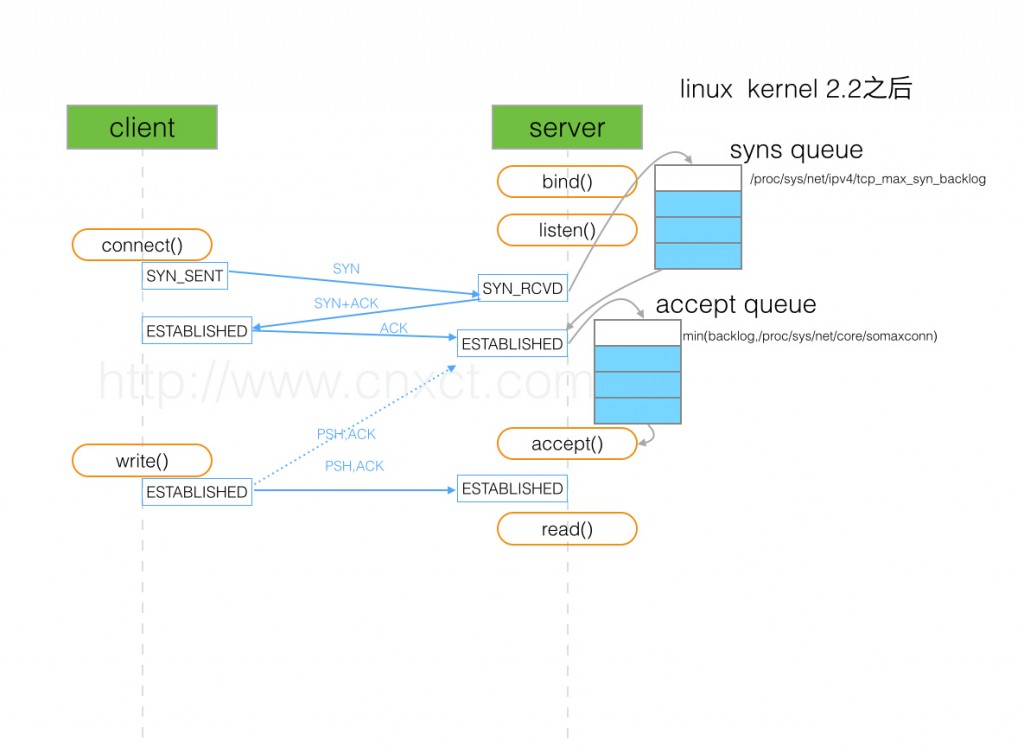在Netty中经常会看到这样的代码:
|
|
这里有一个SO_BACKLOG参数,本篇文章解释一下这个参数的具体用途。
TCP的连接队列
我们看一下TCP三次握手的过程:

- 当 client 通过 connect 向 server 发出 SYN 包时,client 会维护一个 socket 等待队列,而 server 会维护一个 SYN 队列;
- 此时进入半链接的状态,如果 socket 等待队列满了,server 则会丢弃,而 client 也会由此返回 connection time out;只要是 client 没有收到 SYN+ACK,3s 之后,client 会再次发送,如果依然没有收到,9s 之后会继续发送;
- 半连接 syn 队列的长度为
max(64, /proc/sys/net/ipv4/tcp_max_syn_backlog)决定 - 当 server 收到 client 的 SYN 包后,会返回 SYN, ACK 的包加以确认,client 的 TCP 协议栈会唤醒 socket 等待队列,发出 connect 调用;
- client 返回 ACK 的包后,server 会进入一个新的叫 accept 的队列,该队列的长度为
min(backlog, somaxconn),默认情况下,somaxconn 的值为 128,表示最多有 129 的 ESTAB 的连接等待 accept(),而 backlog 的值则由int listen(int sockfd, int backlog)中的第二个参数指定,listen 里面的 backlog 的含义请看这里。需要注意的是,一些 Linux 的发型版本可能存在对 somaxcon 错误 truncating 方式; - 当 accept 队列满了之后,即使 client 继续向 server 发送 ACK 的包,也会不被相应,此时,server 通过
/proc/sys/net/ipv4/tcp_abort_on_overflow来决定如何返回,0 表示直接丢丢弃该 ACK,1 表示发送 RST 通知 client;相应的,client 则会分别返回read timeout或者connection reset by peer。上面说的只是些理论,如果服务器不及时的调用 accept(),当 queue 满了之后,服务器并不会按照理论所述,不再对 SYN 进行应答,返回 ETIMEDOUT。根据这篇文档的描述,实际情况并非如此,服务器会随机的忽略收到的 SYN,建立起来的连接数可以无限的增加,只不过客户端会遇到延时以及超时的情况。
可以看到,整个 TCP stack 有如下的两个 queue:
- 一个是 half open(syn queue) queue(max(tcp_max_syn_backlog, 64)),用来保存 SYN_SENT 以及 SYN_RECV 的信息,其大小通过
/proc/sys/net/ipv4/tcp_max_syn_backlog指定,一般默认值是512,不过这个设置有效的前提是系统的syncookies功能被禁用。互联网常见的TCP SYN FLOOD恶意DOS攻击方式就是建立大量的半连接状态的请求,然后丢弃,导致syns queue不能保存其它正常的请求。。 - 另外一个是 accept queue(min(somaxconn, backlog)),保存全连接状态的请求,其大小通过
/proc/sys/net/core/somaxconn指定,在使用listen函数时,内核会根据传入的backlog参数与系统参数somaxconn,取二者的较小值。
Netty中的backlog参数
查看EpollServerChannelConfig中的backlog参数:
|
|
使用了NetUtil.SOMAXCONN变量的值,在NetUtil中查看:
|
|
可以看到,在默认情况下somaxconn的值为:
- Windows NT Server 4.0+: 200
- Linux and Mac OS X: 128
这里也通过/proc/sys/net/core/somaxconn文件来获取somaxconn的值。
上文中说到,内核会根据传入的backlog参数与系统参数somaxconn,取二者的较小值,所以,如果想扩大accept queue的大小,必须要同时调整这两个参数。